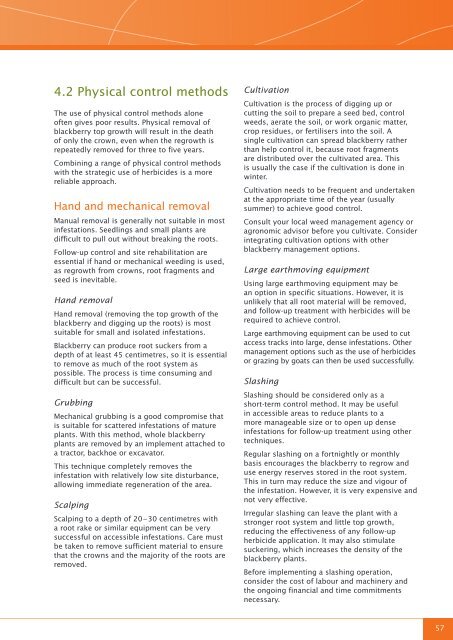Blackberry control manual - Weeds Australia
Blackberry control manual - Weeds Australia
Blackberry control manual - Weeds Australia
You also want an ePaper? Increase the reach of your titles
YUMPU automatically turns print PDFs into web optimized ePapers that Google loves.
4.2 Physical <strong>control</strong> methods<br />
The use of physical <strong>control</strong> methods alone<br />
often gives poor results. Physical removal of<br />
blackberry top growth will result in the death<br />
of only the crown, even when the regrowth is<br />
repeatedly removed for three to five years.<br />
Combining a range of physical <strong>control</strong> methods<br />
with the strategic use of herbicides is a more<br />
reliable approach.<br />
Hand and mechanical removal<br />
Manual removal is generally not suitable in most<br />
infestations. Seedlings and small plants are<br />
difficult to pull out without breaking the roots.<br />
Follow-up <strong>control</strong> and site rehabilitation are<br />
essential if hand or mechanical weeding is used,<br />
as regrowth from crowns, root fragments and<br />
seed is inevitable.<br />
Hand removal<br />
Hand removal (removing the top growth of the<br />
blackberry and digging up the roots) is most<br />
suitable for small and isolated infestations.<br />
<strong>Blackberry</strong> can produce root suckers from a<br />
depth of at least 45 centimetres, so it is essential<br />
to remove as much of the root system as<br />
possible. The process is time consuming and<br />
difficult but can be successful.<br />
Grubbing<br />
Mechanical grubbing is a good compromise that<br />
is suitable for scattered infestations of mature<br />
plants. With this method, whole blackberry<br />
plants are removed by an implement attached to<br />
a tractor, backhoe or excavator.<br />
This technique completely removes the<br />
infestation with relatively low site disturbance,<br />
allowing immediate regeneration of the area.<br />
Scalping<br />
Scalping to a depth of 20 – 30 centimetres with<br />
a root rake or similar equipment can be very<br />
successful on accessible infestations. Care must<br />
be taken to remove sufficient material to ensure<br />
that the crowns and the majority of the roots are<br />
removed.<br />
Cultivation<br />
Cultivation is the process of digging up or<br />
cutting the soil to prepare a seed bed, <strong>control</strong><br />
weeds, aerate the soil, or work organic matter,<br />
crop residues, or fertilisers into the soil. A<br />
single cultivation can spread blackberry rather<br />
than help <strong>control</strong> it, because root fragments<br />
are distributed over the cultivated area. This<br />
is usually the case if the cultivation is done in<br />
winter.<br />
Cultivation needs to be frequent and undertaken<br />
at the appropriate time of the year (usually<br />
summer) to achieve good <strong>control</strong>.<br />
Consult your local weed management agency or<br />
agronomic advisor before you cultivate. Consider<br />
integrating cultivation options with other<br />
blackberry management options.<br />
Large earthmoving equipment<br />
Using large earthmoving equipment may be<br />
an option in specific situations. However, it is<br />
unlikely that all root material will be removed,<br />
and follow-up treatment with herbicides will be<br />
required to achieve <strong>control</strong>.<br />
Large earthmoving equipment can be used to cut<br />
access tracks into large, dense infestations. Other<br />
management options such as the use of herbicides<br />
or grazing by goats can then be used successfully.<br />
Slashing<br />
Slashing should be considered only as a<br />
short-term <strong>control</strong> method. It may be useful<br />
in accessible areas to reduce plants to a<br />
more manageable size or to open up dense<br />
infestations for follow-up treatment using other<br />
techniques.<br />
Regular slashing on a fortnightly or monthly<br />
basis encourages the blackberry to regrow and<br />
use energy reserves stored in the root system.<br />
This in turn may reduce the size and vigour of<br />
the infestation. However, it is very expensive and<br />
not very effective.<br />
Irregular slashing can leave the plant with a<br />
stronger root system and little top growth,<br />
reducing the effectiveness of any follow-up<br />
herbicide application. It may also stimulate<br />
suckering, which increases the density of the<br />
blackberry plants.<br />
Before implementing a slashing operation,<br />
consider the cost of labour and machinery and<br />
the ongoing financial and time commitments<br />
necessary.<br />
57

















